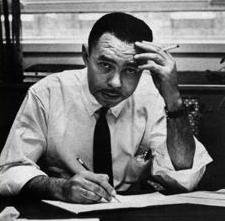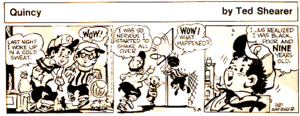Ted Shearer facts for kids
Quick facts for kids Ted Shearer |
|
|---|---|

Ted Shearer
|
|
| Born | Thaddeus Shearer November 1, 1919 May Pen, Jamaica |
| Died | December 26, 1992 (aged 73) Mount Kisco, New York |
| Nationality | American |
| Area(s) | Penciller, Inker |
|
Notable works
|
Quincy |
Thaddeus Shearer (born November 1, 1919 – died December 26, 1992) was an African-American artist. He worked as an art director in advertising. He was also a cartoonist. His comic strip, Quincy, ran from 1970 to 1986. It was one of the first major comic strips to feature an African-American main character.
Contents
Ted Shearer's Early Life and Art Career
Shearer was born in May Pen, Jamaica. His parents were Samuel and Sophie. He grew up in Harlem, a neighborhood in New York City. From a young age, he dreamed of creating a comic strip.
Learning to Draw and Create
When he attended DeWitt Clinton High School, Shearer met E. Simms Campbell. Campbell was an African-American cartoonist who became his mentor. At 16, Shearer sold his first cartoon. It was published in the New York Amsterdam News newspaper. From 1938 to 1940, he studied art at night. He attended the Art Students League on a scholarship.
Serving in World War II
During World War II, Shearer joined the U.S. Army. He served in the 92nd Infantry Division, which was a segregated unit. He became a sergeant. He earned the Bronze Star award. This was for his work as art director for the division's magazine, The Buffalo. He also drew pictures for the military newspaper Stars and Stripes. He created comics about army life for Continental Features.
After the War: Magazine Illustrations
After the war, Shearer started drawing for many magazines. These included The Ladies' Home Journal and The Saturday Evening Post. He also worked for Our World and Collier's. His art appeared in newspapers like the New York Herald Tribune. From 1946 to 1947, he continued his art studies at the Pratt Institute.
Advertising and Comic Strip Success
Shearer created two single-panel comics through Continental Features. Around Harlem was about teens in Harlem. Next Door focused on a family. After these comics ended in the 1950s, Shearer joined BBDO. This was an advertising agency in New York City. He worked there as an art director for 15 years. He won five awards for his advertising work.
Creating the Quincy Comic Strip
While working in advertising, he sold single-panel cartoons to King Features Syndicate. These appeared in their Laff-a-Day feature. One day, he met Bill Gilmartin, an artist for King Features. Shearer showed Gilmartin his work. Gilmartin was impressed and shared Shearer's art with the syndicate.
Through King Features, Shearer launched his own comic strip, Quincy. The strip was about an African-American elementary-school boy. Quincy was being raised by his grandmother in Harlem. The comic strip first appeared on June 13 or June 17, 1970. When Quincy started, Shearer left his job at BBDO. The comic strip ran until 1986, when Shearer retired.
The Impact of Quincy
Comic historian Bill Crouch, Jr. wrote about Quincy. He said Shearer made Quincy a very positive and happy comic. Quincy had a white best friend. This was a playful take on the saying, "Some of my best friends are black." Crouch also noted that Quincy's artwork was strong and visually appealing.
Another comic historian, Don Markstein, said Quincy was not preachy. He explained that the characters were clearly minorities in their daily lives. They often found humor in this fact. But they were not loud activists for change. Mostly, they were just kids who got along well. They didn't think much about their racial identity.
Billy Jo Jive Books and Cartoons
Ted Shearer also worked with his son, John Shearer. John was a photojournalist and writer. Together, they created the Billy Jo Jive book series. These books later became animated segments. They were shown on the PBS children's show Sesame Street. An animated movie, Billy Jo Jive Super Private Eye, was also made in 1979.
Later in his life, Shearer showed his paintings in many art shows.
Ted Shearer's Personal Life
In 1945, Shearer married Phyllis Wildman. She was an attorney. Later, she became a deputy commissioner of social services in Westchester County, New York. They had a son, John Shearer, who became a photographer. They also had a daughter named Kathleen.
Shearer helped start the Westchester Clubmen. This was a group for African-American professionals. He was also a member of the National Cartoonists Society. He belonged to the Society of Professional Journalists as well.
Shearer lived in Pound Ridge, New York. He passed away from a cardiac arrest (heart attack) at Northern Westchester Hospital in Mount Kisco, New York.


